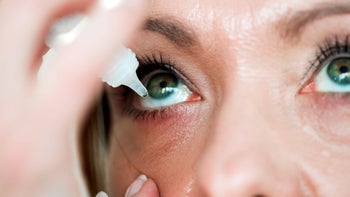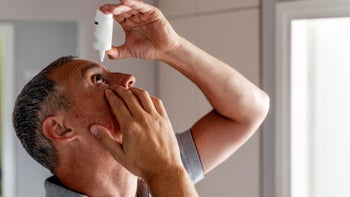
What Strength Reading Glasses Do I Need?
Key takeaways:
Because of presbyopia, it’s normal to need reading glasses after age 40.
Most 40-year-olds can start with low-strength reading glasses (+1.25 or +1.5), increasing to higher-strength readers every few years.
By their 60s, most people will need reading glasses with a strength of +2.5 or higher to read comfortably and clearly.
Table of contents

You might think of reading glasses as a sign of getting older. But the fact is, many younger people need to start using them in their 40s — or even earlier.
As we mature, our eyes change, and it becomes more difficult to see objects clearly when they’re up close. This gradual decline in eyesight is called presbyopia. Trouble focusing on and reading small print can be one of the first signs.
The good news is that presbyopia is a natural and normal experience, and there are plenty of options for dealing with its effects. For most people with presbyopia who’ve never needed glasses before, over-the-counter (OTC) reading glasses are a safe and effective solution.
Search and compare options
How do reading glasses work?
As we age, our most comfortable reading distance gets farther and farther away from where it was when we were younger. This is because the natural lenses inside our eyes get stiffer over time, making it harder to focus on anything up close.
Reading glasses pull your comfortable focus point closer to you. They help you see closer in than you naturally can. The stronger your reading glasses, the closer they will help you to see.
Are reading glasses just magnifiers?
No, although many people think of them this way. A magnifying lens makes things appear larger. Reading glasses actually move your clearest point of focus to a distance closer to you.
Understanding reading glasses strengths
Picking out your first pair of reading glasses can be confusing. Often, store displays contain a mix of glasses labeled with different numbers. This makes it hard to know where to start.
What’s the difference between +1.00, +1.25, and +1.50 reading glasses?
Reading glasses come in a variety of strengths. Their strength is shown in diopters. These are units that describe the corrective power of a lens based on how near or how far your clearest area of focus is to your eye. A negative number represents nearsightedness, while a positive number means farsightedness.
The higher the number of diopters, the stronger the power of the glasses. This means +1.50 diopters are stronger than +1.00 diopters. Put another way, the higher the number, the closer you’ll be able to see.
Presbyopia versus hyperopia: Learn about the differences between these vision problems.
Blue light glasses: Do they work? And are they worth it?
Effects of wearing glasses: No, they don’t make your eyesight worse over time.
On an OTC display, you might find glasses that range from +0.75 to about +3.5 diopters.
What is the highest strength for reading glasses?
It’s easy to find reading glasses up to about 3 diopters (+3.00) over the counter. Higher strengths, which can be useful for very fine close-up work or very small print, are harder to find. You may need to place an online order or talk to an eye care specialist for glasses with higher corrective power.
What is the lowest strength for reading glasses?
The lowest strength for reading glasses is +0.25 diopters. But it might also be hard to find anything below +0.75 or +1.00 over the counter.
Read more like this
Explore these related articles, suggested for readers like you.
What strength reading glasses should I look for?
The best way to find the right strength of reading glasses is to try on different pairs. Test how easily you can read standard-sized writing at distances that are comfortable for you.
It’s possible you’ll need more than one pair of readers. You might prefer stronger glasses for very close activities like reading or beadwork. But weaker glasses may be better for activities that are a bit farther away, like seeing a computer screen or woodworking. Remember, the higher the number, the closer you’ll be able to see.
Most likely, you’ll need different reading glasses over time. This is because your natural lenses will continue to get stiffer, and your natural focus point will move farther away. Many people increase the strength of their reading glasses every few years until about age 60, when presbyopia usually stops changing.
How do I know if I need reading glasses or prescription lenses?
Reading glasses are designed to help you see up close. They’re helpful for reading and tasks that require near vision.
If you see well at a distance but are finding it hard to read small print, OTC reading glasses from a drugstore will probably work well for you.
On the other hand, if your vision is blurry at a distance, reading glasses aren’t going to do the trick. Talk to an eye care professional about solutions to help you see both up close and at a distance.
What if I wear glasses or contacts already?
If you wear contacts or have had refractive eye surgery (like LASIK), it can still be helpful to add reading glasses when presbyopia kicks in. That’s because your eyes have been corrected — either surgically or because of your contacts — to see well at a distance. But focusing up close is another matter, and it’s still going to get more challenging as you get older.
The situation is a bit different if you wear glasses every day. That’s because you’ll need to take your glasses off to put on readers. This affects the strength of the reading glasses you’ll need:
If you’re farsighted — that is, you already wear glasses to see up close — you’ll likely need stronger reading glasses to start with.
If you’re nearsighted — meaning you wear glasses to see far away or to drive — you can probably start with lower-strength readers.
If you’re already wearing prescription glasses every day, adding readers may not be a great solution. Making the switch to bifocals or progressive lenses might make more sense than juggling two pairs of glasses.
Reading glasses resources and calculators
If you’re shopping online or trying to figure out where to start when trying on reading glasses, it can be helpful to use a reading glasses calculator. These tools use information about your age and reading habits to make recommendations about which strength might work best for you.
That said, the only way to know if you’ve picked the right reading glasses is to try them on. Your own personal preferences play a role in how close you can comfortably focus and how far away you like to hold your newspaper.
What if my reading glasses are too strong?
If wearing your new reading glasses makes you want to hold a newspaper closer than usual, that could be a sign that they’re too strong. Don’t worry — this won’t hurt you, but you might not enjoy reading that way.
It’s worth pointing out that presbyopia happens because the natural lenses in our eyes get stiffer and harder to bend over time. This change occurs because of chemical shifts within the lenses themselves. However, to bend, our lenses are pulled by tiny muscles inside our eyes. Some believe that wearing overly strong reading glasses could mean less exercise for those tiny muscles. And if those muscles grow weak, bending those stiff lenses could get even harder. The result could be presbyopia progressing slightly faster than it otherwise might.
Are over-the-counter reading glasses safe?
Reading glasses are both safe and effective. You won’t hurt your eyes by wearing them. And it won’t hurt anything if you choose not to wear them. The changes of presbyopia are going to happen either way.
Can I wear my reading glasses all the time?
Yes, but wearing reading glasses can make it harder to focus on objects that are farther away. If you want to keep your reading glasses on all the time, consider trying half-rimmed reading glasses. This way, you can peek above them when you want to see something at a distance.
Can you watch TV with reading glasses?
You won’t hurt your eyes by watching TV with reading glasses, but they aren’t designed for that. If you find that reading glasses help you see the TV, it could be a sign that you need prescription glasses for other distance activities, like driving or golfing. If that’s the case, it’s worth booking an eye test.
I don’t want reading glasses! Are there other options?
If you don’t like reaching for your readers every time you want to see something up close, there are other ways to manage the effects of presbyopia.
Specialized lenses
Bifocals and progressive (no-line bifocal) prescription glasses combine up-close and distance prescriptions into a single lens.
Bifocal lenses have reading glasses on the bottom and a prescription for distance vision on the top. These are convenient because you can wear the same pair of glasses all the time, no matter what you’re doing.
If you like the idea of bifocals but you don’t need a prescription for distance vision, you can get the top part with clear glass.
Contact lenses
Bifocal contact lenses are also available. These work a bit differently from bifocal glasses but still combine different prescriptions into a single lens that you wear all the time.
Monovision, where one eye has a prescription to see up close and the other eye has one for distance, is another option for some people with presbyopia.
Surgery
Surgery can occasionally be an option for people with presbyopia, especially if they’re developing cataracts. During cataract surgery, multifocal lenses (similar to bifocal lenses) can sometimes be implanted inside your eyes.
LASIK and other types of refractive surgery are occasionally used for presbyopia. But these options are tricky solutions, in part because your natural focus will continue to change over time.
The bottom line
Reading glasses are an easy, safe, and effective solution for the loss of up-close vision we all experience as we age. Different strengths of reading glasses are available. Although the numbers can be confusing, it’s helpful to remember that the higher the number of diopters on the label, the closer you’ll be able to see. The best reading glasses for you are the ones that allow you to do the things you want to do, at the distance that’s most comfortable for your eyes and your body.
Why trust our experts?



References
Readingglasses.com. (n.d.). How reading glasses work.
Tiger Specs. (n.d.). Calculate my reading glasses strength.





























